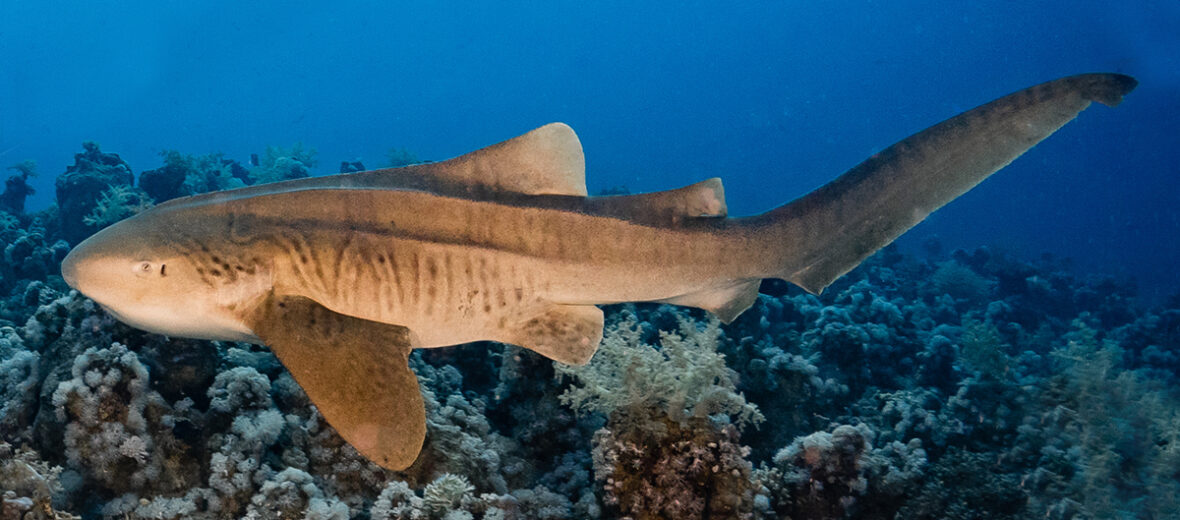
The zebra shark is a species of carpet shark and the only member of the Stegostomatidae family. They can be seen throughout the tropical Indo-Pacific waters. These sharks prefer sandy flats and coral reef habitats. Unfortunately, due to overfishing and the cruel practice of finning (catching sharks, cutting off their fins, then throwing them back into the ocean), these sharks are listed as Endangered by the IUCN. Their numbers are also decreasing.
First the Stats…
Scientific name: Stegostoma tigrinum
Weight: Up to 65 lbs.
Length: Up to 8.2 feet
Lifespan: Up to 30 years
Now on to the Facts!
1.) These sharks can be found off the coasts of Australia (New South Wales, Northern Territory, Queensland, Western Australia); Fiji; Indonesia; Marshall Islands; New Caledonia; Palau; Papua New Guinea; Solomon Islands; Timor-Leste; and Tonga.
2.) Like many sharks, zebra sharks are nocturnal (active at night).
3.) Crustaceans, molluscs, small bony fishes, and sea snakes are all on the menu.
4.) These sharks were first described by Albert Seba in 1758 as Squalus varius. However, in 1837, Johannes Peter Müller and Friedrich Gustav Jakob Henle placed these sharks into the genus Stegostoma. The current name proposed by Forster in 1781 has been used in tens of publications since circa 1899.
5.) The genus name hails from the Greek stego meaning “covered”, and stoma meaning “mouth”. The specific epithet fasciatum translates to “banded”, and refers to the striped patterning of juveniles.
But wait, there’s more on the zebra shark!
6.) These sharks typically dwell in shallower waters at a depth of up to 203 feet.
7.) Females are oviparous (lay eggs), and lay up to 40+ large egg capsules each breeding season. The eggs hatch in to to 6 months, based on the ambient temperature.
Did you know…?
In 1964, a 6.2 foot long, partially albino zebra shark was discovered in the Indian Ocean. Most albino or partially albino creatures rarely survive long due to their lack of crypsis (the ability to avoid detection and subsequent predation by other animals).
8.) There have been reports, albeit unsubstantiated, of these sharks dwelling in fresh water bodies in the Philippines.
9.) During the day these sharks are often found resting along the ocean floor, slightly propped up by their pectoral fins, and facing the current to allow oxygenated water to flow into their open mouths and over their gill filaments. This is called passive respiration.
10.) These sharks don’t need to constantly swim in order to get oxygen to their gills. The need to swim to respirate is called obligate ram ventilation.
But wait, there’s still more on the zebra shark!
11.) The zebra shark is preyed on by larger fish, other sharks, and sea mammals.
12.) They have small mouths but a thickly muscled buccal cavity (the space between the head and neck) that allows these sharks to create a powerful suctioned force used to extract prey from crevices.
Did you know…?
Although typically docile in nature and not likely to bite, there have been divers bitten by these sharks do to careless behaviors, such as holding their tail or even attempting to ride the sharks.
13.) While typically solitary, large shivers of these sharks, numbering up to several hundred have been documented. These shivers consist primarily of female sharks, which outnumber males 3 to 1.
14.) During these gatherings it has been witnessed by scientists that some male sharks will bite the dorsal fin of other males and will then push them to the sea floor. The recipient of the aggressive move will then remain on it’s back for some time before swimming off. This is presumed to be a submissive behavior by the recipient.
15.) Courtship behavior entails the male almost aggressively biting the tail and fins of the female, holding her down on the ocean floor. Copulation then takes place, the male then leaving the female.
Now a Short Zebra Shark Video!
Be sure to share & comment below! Also, check out the Critter Science YouTube channel. Videos added regularly!
Want to suggest a critter for me to write about? Let me know here.
Some source material acquired from: Wikipedia & IUCN
Photo credit: Xaime Beiro



